Background
In late 2013, the Factor Four Team worked at understanding the best way to proceed with improving the energy performance of NE1, the last piece of the Factor Four puzzle.
NE1 is described by many as “not an ideal building” (from air quality to space layout to energy consumption). Should BCIT keep the building and proceed with a renovation project? Or should BCIT replace NE1 with a new building? What energy performance level would be needed to support the Factor Four initiative? These are all questions the Factor Four team needs to answer.
Problem and/or Opportunity
Based on the other ECMs (Energy Plan – Click Here), to meet the Factor Four energy reduction target of 75% reduction, NE1 would have to perform at approximately 70 kWh/m2 per year (0.25 GJ/m2 per year) or 1,400,000 kWh (5,000 GJ) per year. It currently performs at 240 to 270 kWh/m2. However, these energy numbers reflect the reality that NE01 is not a comfortable building. If operated to meet the ASHRAE 62.1 and 55 standards for air quality and thermal comfort, the energy consumption is estimated at 345 kWh/m2.
Because of embodied energy, the Factor Four approach typically gives priority to adapting the existing infrastructure rather than building new. NE1 has recently been surveyed for seismic risk and for deferred maintenance value. The reports show that it would be more economical to demolish NE1 and build from scratch. However, the NE1 file shows that it might be standing and providing services to the BCIT community for another 10 to 15 years.
With many stakeholders involved and many factors to consider, the Factor Four team decided to start by hiring Sandra Rohler of RPHD to perform an analysis of the present situation and determine what direction to take.
Recommendations
In the long term:
The recommendations are to proceed with a series of activities involving our students in some early work towards developing a new NE1-equivalent that would meet the Passivhaus Standard for commercial buildings (or equivalent energy performance). Part of the exercise will focus on understanding the business case for the Passivhaus Standard for commercial buildings in comparison to LEED Gold and ASHRAE 90.1. You can read the entire rationale behind this decision at: BCIT NE1 Scope Definition Report by RPHD. The work with the students will start in September 2014. Refer to the NE1 as a passive building (new construction) case study for all details.
Important note: BCIT has not committed yet to building our new NE1 building to the Passivhaus Standard (or equivalent). This is an exercise driven by the Factor Four team with collaboration from BCIT’s Campus Development.
In the short term:
In the meantime, there was an opportunity to look as some short term interventions that could improve the energy consumption of NE1 and comfort of its occupants (with the concepts of passive buildings in mind). We know that the existing NE1 building will be standing for another decade or more. Any fixes with a payback shorter than the remaining life of the building could be considered.
This is why a workshop with Transsolar and Faculty and Students from Architectural Sciences, Building Science and Sustainable Energy Management as well as BCIT’s Facility Services and BCIT’s Campus Development was organized on March 12th, 2014.
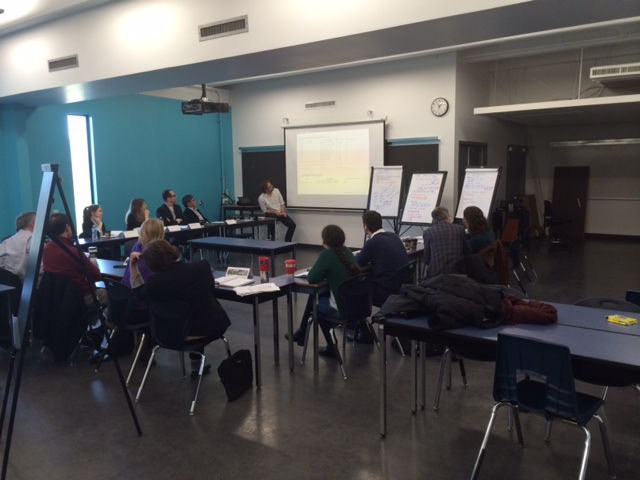
Faculty and Students during a half-day workshop (March 12th, 2014) with Josh Vanwyck from Transsolar.
Before and after the workshop, BCIT’s Factor Four team worked with Anna Lermer and Josh Vanwyck from Transsolar at understanding the building and the type of interventions that could be made.
The findings are surprising:
Technologies that could be Implemented in the short term (existing building renovation)
[Below are presented extracts from the BCIT_NE1_FINAL_REPORT_TRANSSOLAR]
1) Building-Wide Ventilation: Split HVAC with Natural Ventilation
The first step in reducing the energy demand and increasing the comfort level of NE01 is separating conditioning and ventilation, and installing all operable windows along the facades for natural ventilation and night flushing. A radiative conditioning system allows the ventilation system to be driven by air quality rather than heating requirements and fresh outdoor air can be supplied through natural ventilation to rooms along the façade for the majority of the year. The use of natural ventilation and night flushing also eliminates cooling needs for spaces with window access and provides users with more control over the thermal comfort and air quality of their space. Energy savings of 49% is achievable through this combined strategy.
2) Façade Improvements
To further reduce NE01’s heating demand, the current façade should be enhanced by installing double glazed windows and adding internal insulation along the building facade. This will reduce heat loss through the façade, resolving thermal comfort issues (downdraft and sensation of being cold despite warm air) and reducing heating demand.
3) Integration of Heat Recovery in Ventilation System
To further reduce NE01’s heating demand, heat recovery should be implemented. Although excess heat from the buildings exhaust air is already being used through air recirculation, employing heat exchange rather than air recirculation improves air quality immensely, and can reduce heating needs even more. Due to the variation in the ventilation system throughout the building, the system should be investigated unit by unit for the potential to integrate heat recovery. In the case that NE01’s entire ventilation system is replaced, air handling units with high efficiency heat recovery should be selected.
4) Lighting Upgrades
Finally, the combination of LED lighting and lighting controls in various common spaces (bathrooms, cafeteria, corridors, and staircases) is recommended to reduce the electricity demand of NE01. By introducing LED lighting in these spaces, dimming is possible, and the lifespan of the light bulbs is not reduced.
Energy Savings and GHG Emissions Reductions
If built or renovated to meet the Factor Four overall energy reduction target, the NE1 project would have the following savings:
- 12,700 GJ per year (3,500,000 kWh per year)
- 450 CO2eq per year
- $200,000 per year of energy and GHG cost savings
Additional Benefits and Features
Air quality and occupant comfort:
To better understand NE01’s current state and explore intervention possibilities, a design charette was led by Joshua Vanwyck, Project Lead at Transsolar, to engage BCIT students, faculty and facility managers. One main insight from this design charette was the poor air quality and thermal comfort in the building. The air in NE01 was described as stuffy and stale, causing headaches and other symptoms from prolonged exposure. The ventilation system operation was identified as the key source of this problem, with low levels of ventilation throughout the day, recirculation of “wasted” return air, and system shut-off while the building is still occupied. The thermal comfort is also a key issue due to the low insulation level in the façade and the limited ventilation operation hours mentioned above. The four interventions recommended by Transsolar would all contribute to making the building more comfortable for its occupants.
Living Lab:
Based on Transsolar’s experience with applied research projects, and in office initiatives, and examples from other university campus living labs, at least three focuses are possible: room-level energy system optimization, comfort studies, and building wide energy reduction optimization. The NE1 Factor Four project creates many great opportunities to get both Faculty and Students involved in applied research and hands-on learning.
Refer to BCIT_FINAL_REPORT_TRANSSOLAR.pdf for more details on how the Factor Four team might embrace the Living Lab concept in NE1.
Project fast facts
- Up to 12,700 GJ per year (3,500,000 kWh per year)
- Up to 450 CO2eq per year
- Up to $200,000 per year of energy and GHG cost savings
Project partners
A list of project partners will be published as soon as it becomes official.
Project folder
Reports:
More Information:
- Learn more about building NE1
- Learn more about Transsolar
- Learn more about the passivhaus standard
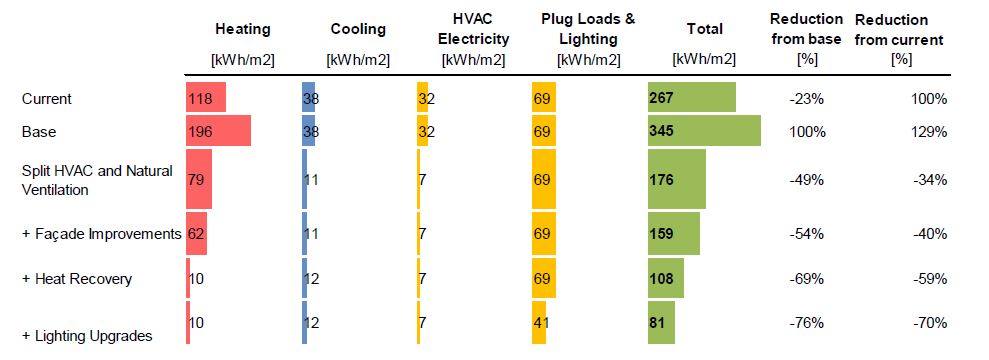
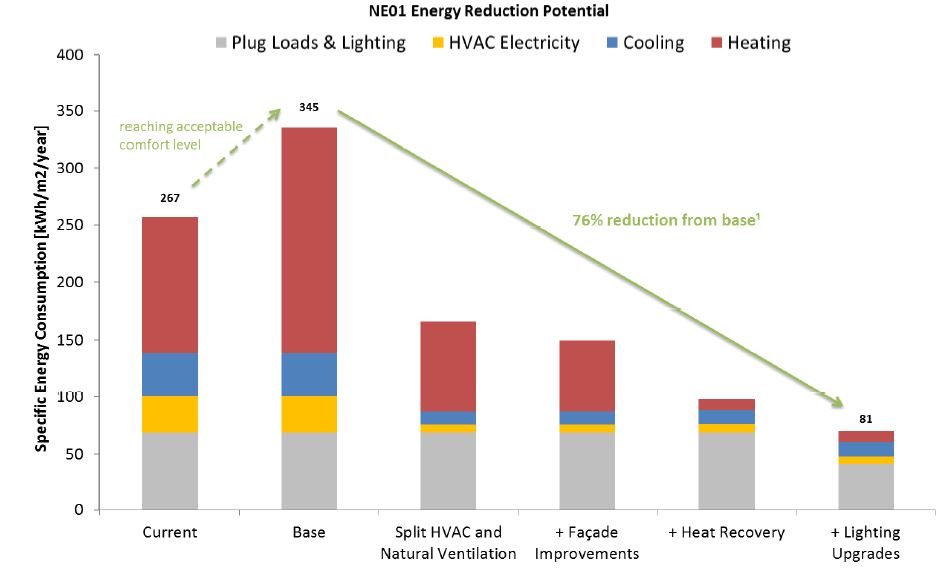
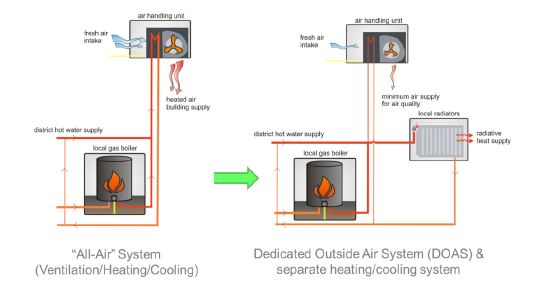


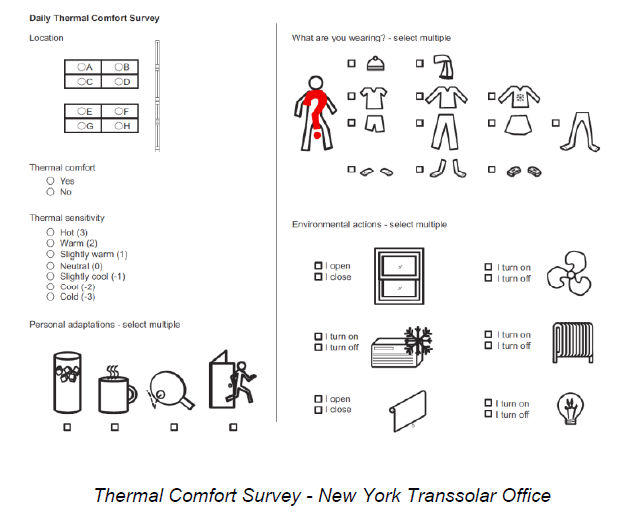
Leave a Reply